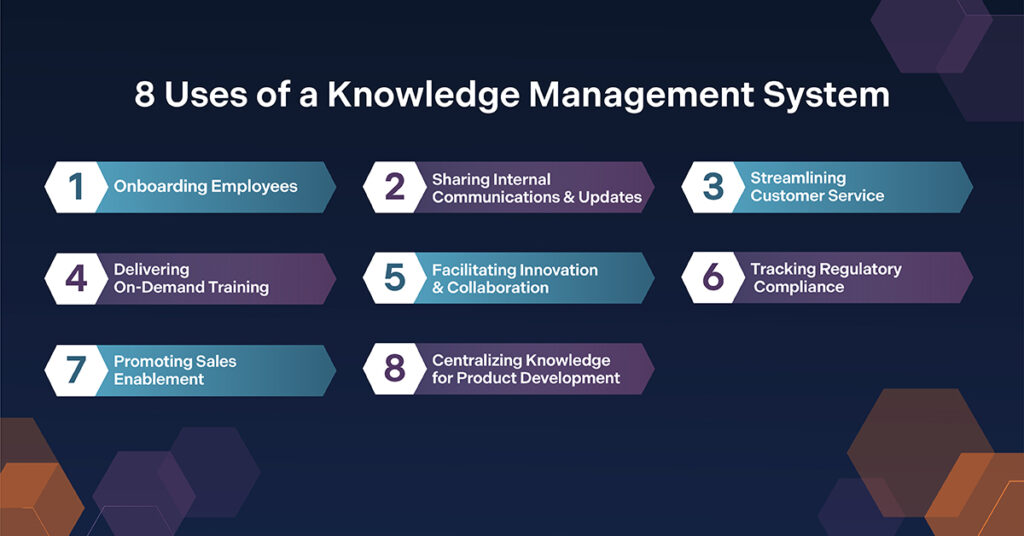What Is a Knowledge Management System?

Harnessing the collective intelligence within an organization is no longer a luxury but a strategic imperative. A robust knowledge management system (KMS) is the key to this initiative, empowering businesses to streamline operations and forge a competitive edge through enhanced innovation and informed decision-making.
Companies can foster innovation, improve customer service, and enhance decision-making by efficiently managing organizational knowledge. But what is a knowledge management system, and how can it transform your enterprise?
Defining a Knowledge Management System
A knowledge management system is a technology-based system that enhances information capture, organization, and sharing across an organization. It acts as a centralized platform, often cloud-based, to streamline access to corporate knowledge. However, the definition of a knowledge management system extends beyond just software; it includes the strategies employed to foster knowledge creation, dissemination, and utilization.
Since it consolidates critical information into one central hub, a knowledge management system moves away from fragmented systems, becoming the primary repository for shared knowledge. These typically include emails, locally saved files, and company intranets. As a result, it makes it easier for employees to find what they need and supports a culture of continuous learning and knowledge retention.
A KM System With AI Capabilities
Leverage the power of AI when you use Bloomfire for managing knowledge in your company.
Explore Bloomfire
What Is the Purpose of a Knowledge Management System?
The primary purpose of a knowledge management system is to ensure that the right information reaches the right person at the right time. This empowers employees to make informed decisions and perform their jobs more effectively.
A KMS enhances company data and expertise access, streamlines processes, and facilitates organizational learning. Consider a multinational manufacturing firm that implements a KMS to document troubleshooting procedures for its machinery. When a technician in a remote location encounters a novel issue, they can quickly search the KMS for similar past incidents and their resolutions. As a result, it minimizes downtime and fosters a culture of shared problem-solving.
The strategic integration of a KMS gives way to a collaborative environment, promoting a more informed and aligned workforce. It accommodates diverse information in documents, videos, presentations, FAQs, and audio files. This flexibility guarantees that employees can contribute to and leverage the system, transcending departmental and role-based boundaries.
How Does a Knowledge Management System Work?
A knowledge management system functions through a cyclical process designed to effectively capture, store, share, and utilize collective knowledge. It begins with knowledge enrollment, identification, and organization into the system. Various methods facilitate this, including document creation tools, interview recordings, and brainstorming sessions.
Once captured, the knowledge undergoes organization and storage within a central repository, often leveraging taxonomies, tagging, and categorization to ensure easy retrieval. With the amount of data organizations handle, using multiple platforms for knowledge management can become a nightmare.
A KM World Survey Report highlights a significant challenge: 54% of organizations rely on over five different platforms for internal documentation and information sharing. If you’re already using a centralized KM system, consider it an advantage in facilitating productivity in your organization. Otherwise, you may want to secure a KMS with advanced search capabilities and more.
The core of a KMS lies in its ability to make this stored knowledge accessible to users when and where they need it. Robust search functionalities, often powered by natural language processing and AI, allow users to find relevant information quickly.
Collaboration tools may also be integrated, enabling users to share knowledge, ask questions, and contribute to the knowledge base. Furthermore, analytics and reporting features can track knowledge usage and identify areas for improvement or gaps in the existing knowledge.
Types of Knowledge in a Knowledge Management System
All knowledge is valuable, but you can generally categorize knowledge into three types: explicit, implicit, and tacit. Understanding the three types of knowledge can help you determine the best way to organize and share it within your company.
Explicit knowledge
Explicit knowledge is the most basic form of knowledge. It is easy to articulate, record, store, and share. This typically includes information like white papers, data sheets, research reports, documented processes and policies, product information, and brochures in a business environment.
Implicit knowledge
Implicit knowledge is the practical application of explicit knowledge. It is often gained through experience, context, and incidental activity without the awareness that learning is happening. For example, your company may have documented diagrams and processes (explicit knowledge) for operating a software program. Understanding and using that information to operate the program is an example of implicit knowledge.
Tacit knowledge
Tacit knowledge is information gained from personal experiences and insights that are difficult to write down or articulate. An example might be a sales rep being able to identify when a prospect is open and ready to hear a pitch or adopting the mannerisms and personalities that engage an audience during a presentation.
8 Uses of a Knowledge Management System
Companies use knowledge management systems in several different ways at the department level and across the entire organization. These systems help capture and share valuable expertise, improving decision-making and problem-solving capabilities. Below are a few of the most common uses.

1. Onboarding employees
Your company’s onboarding experience matters. Managers want their team members to get up to speed as quickly and efficiently as possible, and new hires want to feel confident they have the resources they need to start being as productive as possible. Our report on the value of enterprise intelligence shows that new employees initially spend roughly 22% more time searching for information. However, the right knowledge management tools can save 4.7 hours weekly, boosting onboarding productivity by about 11.7% weekly.
Using a knowledge management system from day one gives new employees on-demand access to all the resources they need to learn about the company. These include the products, policies, and everything else they need to do their job.
2. Sharing internal communications and updates
Important company updates can get lost when shared in a single email or via tool integrations like Slack or Microsoft Teams channels. A knowledge management system lets businesses share company-wide updates in one central, searchable place. Bloomfire also lets companies add featured content to a customized homepage and automatically send notifications over various channels so that nobody misses timely updates.
3. Streamlining customer service
Customer service teams can use a knowledge management system to put answers to customers’ questions at their agents’ fingertips. When a customer calls (or chats with) an agent, the agent can perform a quick keyword search in the knowledge management platform to find relevant, approved information they can use to assist the customer. This helps reduce average handle time (AHT), improve first-call resolution, and reduce the number of calls that must be placed on hold or transferred.
4. Delivering on-demand training
While there’s still a time and place for formal training sessions, knowledge management systems give employees another (asynchronous) way to learn. When training resources, such as video tutorials, how-to guides, and FAQs, are centralized in a knowledge management system, employees can pull them up whenever they need to refer to them. A knowledge management system also helps break training down into bite-sized components that are easy for employees to digest in the flow of work.
5. Facilitating innovation and collaboration
A knowledge management system is a dynamic platform that enables team members to contribute ideas, share insights, and work together on projects across geographical and departmental boundaries. With its centralized space where employees can easily access and build upon each other’s knowledge, a KMS fosters continuous innovation and creativity. This collaborative ecosystem accelerates the development of new products and services and enhances problem-solving capabilities, ensuring that the organization remains competitive.
6. Tracking Regulatory Compliance
Regulatory compliance demands meticulous tracking, which a knowledge management system can help with. A KMS centralizes relevant documentation, updates, and audit trails. It systematically captures and organizes regulatory requirements, facilitates version control for policy documents, and automates notifications for compliance updates. It creates a searchable repository that streamlines audits and demonstrates adherence to evolving standards, minimizing risk and fostering a culture of accountability.
7. Promoting Sales Enablement
Data reveals that 46% of sales enablement professionals cite excessive time spent by sellers on content creation/personalization. A robust KMS mitigates this issue by ensuring that sales teams access timely, pertinent, and readily deployable content.
The strategic implementation of a knowledge management process and system significantly enhances sales enablement, acting as a centralized repository for crucial resources like product information, competitive analyses, and successful sales strategies. This accessibility empowers sales teams to quickly retrieve relevant data, tailoring their pitches and responses to specific client needs, leading to increased efficiency and higher conversion rates.
8. Centralizing Knowledge for Product Development and Management
A KMS acts as the organizational brain trust, consolidating disparate pieces of product development and management information into a unified, accessible repository. These systems capture everything from market research and customer feedback to engineering specifications and project timelines, ensuring all stakeholders operate with a shared understanding.
For instance, a software company might use a system to house bug reports, feature requests, and code documentation. In turn, it makes it easier for developers, testers, and product managers to resolve issues and plan future releases efficiently.
The Intersection of AI and Knowledge Management
The synergy between artificial intelligence (AI) and knowledge management marks a significant leap forward in how organizations manage and utilize information. With AI integration, knowledge management systems can streamline information capture and organization. It can also enhance content delivery through personalized recommendations and automated classification.
These upgrades in KM capabilities dramatically enrich user experiences and propel search capabilities to new heights. Consequently, it paves the way for AI and KM to work hand in hand to unlock unprecedented efficiencies and insights. In 2025, 41% of KM experts identified AI integration as a top priority for knowledge management teams, reflecting its expanding role in optimizing how organizations handle and utilize knowledge.
Specifically, techniques like machine learning can analyze user behavior and content consumption patterns to predict information needs and proactively surface relevant resources. Moreover, semantic search, powered by AI, goes beyond keyword matching to understand the context and meaning of queries, delivering more accurate and comprehensive search results.
Example of a Knowledge Management System With AI Capabilities
Enterprise intelligence platforms like Bloomfire offer a comprehensive KMS with features to streamline these processes, including integrated AI features that transform static knowledge into actionable intelligence. Its architecture typically includes a centralized content repository built on a secure and scalable infrastructure.
Bloomfire also provides advanced search capabilities, including full-text indexing and filtering, to ensure users can efficiently locate information. Collaboration is facilitated through features like Q&A forums, communities, and the ability to co-create and comment on content. It emphasizes knowledge curation and governance, allowing administrators to manage content quality and user permissions.
Who Uses a Knowledge Management System?
Knowledge management systems operate beyond organizational hierarchies, providing valuable insights and efficiently sharing knowledge across all levels. They ensure effortless accessibility, supporting strategic and data-driven decision-making in daily operations. This key benefit of knowledge management as an institutional process cultivates informed decision-making and continuous learning within the organization.
Executives
Executives use a knowledge management system to inform strategic decisions, track industry trends, and monitor organizational performance. Access to comprehensive analytics and reports allows them to identify opportunities for growth and areas of improvement, ensuring that the company’s strategy aligns with its long-term goals.
Managers
Managers rely on knowledge management systems to oversee project workflows, facilitate collaboration, and ensure their teams follow through with organizational objectives. A KMS enables them to distribute resources effectively, share important updates, and oversee their team’s progress and productivity.
Team members
Team members use a knowledge management system to access necessary documents, procedures, and best practices, enabling them to complete tasks more efficiently. The system also allows them to contribute knowledge and learn from their peers’ collective experience, fostering a collaborative work environment.
Employees in sales, marketing, and customer support will most especially benefit from a KMS. This is because they can rely on the system to quickly access information needed to interact with customers, answer inquiries, resolve issues, and provide consistent and accurate information.
Subject matter experts (SMEs)
These individuals possess specific expertise and are responsible for creating, updating, and sharing their knowledge within the KMS. SMEs contribute training materials, articles, documents, FAQs, and other content based on their experience and understanding. This group ensures the KMS remains relevant and accurate.
Frequently Asked Questions
What is the role of knowledge management systems in business?
Knowledge management systems empower employees with easy access to critical information, fostering informed decision-making and streamlined workflows across departments. Through efficient knowledge sharing and retrieval, businesses can enhance collaboration, accelerate learning, improve problem-solving capabilities, and drive innovation and competitive advantage.
Who should own your knowledge management system?
Often, no single department or executive owns knowledge management or is solely responsible for KM implementation. While initiatives can originate from various leadership areas like marketing, CX, L&D, operations, or strategy, a cross-functional team is crucial for aligning KM with organizational goals and preventing knowledge silos. This will help you tie knowledge management to your organization-wide goals and avoid siloing valuable knowledge within specific departments.
What is knowledge management’s impact on organizational performance?
One of the most significant ways knowledge management improves organizational performance is by reducing the time spent searching for information and increasing efficiency. 80% of Bloomfire customers report that their users save at least one to two hours per week, with 30% reporting that users save three or more hours per week. Because knowledge management frees employees up to spend more time on impactful activities, it directly translates to cost savings. You can use our ROI calculator to estimate how much your organization could save.
How does a knowledge management system help the employee experience?
Nobody wants to waste time at work searching multiple content repositories or trying to track down the right subject matter expert to get the information they need. With a knowledge management system, employees can quickly self-serve the information they need whenever needed. 90% of Bloomfire users report feeling less frustrated at work since adopting a knowledge management system, with 83% reporting that their quality of work has also increased.
Secure Your Organization’s Future with Effective Knowledge Management
Effective use of knowledge management systems is critical for fostering better collaboration, ensuring employees are well-informed, and enhancing the customer experience. You can choose the right knowledge management system for your business with a thorough understanding of the software solutions available and the knowledge critical to your company’s success.
Unveil Bloomfire’s Powerful Features
Explore Bloomfire’s core capabilities to enhance knowledge sharing and collaboration.
Talk to an Expert

How to Improve Customer Service in Call Centers: 21 Ways to Enhance Contact Center Experience

Innovative Ways Companies Are Using Knowledge Management

How to Implement a Knowledge Check in 6 Steps

Estimate the Value of Your Knowledge Assets
Use this calculator to see how enterprise intelligence can impact your bottom line. Choose areas of focus, and see tailored calculations that will give you a tangible ROI.

Take a self guided Tour
See Bloomfire in action across several potential configurations. Imagine the potential of your team when they stop searching and start finding critical knowledge.